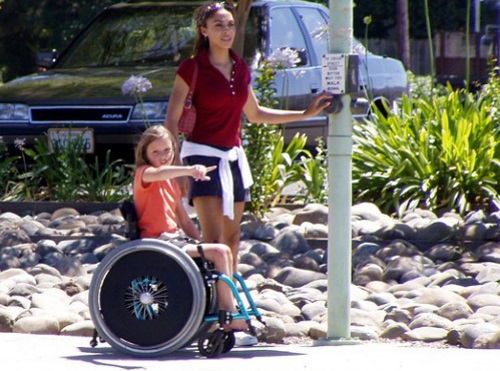The Federal Highway Administration has issued new guidance to help states better protect “vulnerable road users,” such as pedestrians, cyclists, and people who use wheelchairs – people who accounted for approximately 20 percent of the 42,915 killed in motor vehicle crashes in 2021, according to the National Highway Safety Administration; an increase of 13 percent over 2020.
[Above photo by FHWA]
FHWA noted in a statement that its new guidance provides “additional clarity” for states as they develop “Vulnerable Road User Safety Assessments” mandated by the $1.2 trillion Infrastructure Investment and Jobs Act or IIJA enacted in November 2021.
Those assessments seek to track the safety performance of individual states, identify areas of high risk to vulnerable road users, and determine what safety improvements will mitigate these safety risks, the agency said. They also play a key role within the National Roadway Safety Strategy or NRSS unveiled by the U.S. Department of Transportation in January.

FHWA noted that the IIJA requires Vulnerable Road User Safety Assessments developed by states to identify areas of “high risk” driven by demographic and performance related data developed in consultation with local governments that also represent high-risk area.
In developing these assessments, FHWA is encouraging states to work with institutional, advocacy, and community groups, particularly those that represent populations that are involved in these crashes and reside in the locations where fatalities and serious injuries are occurring.
Once completed, FHWA encourages states to use their Vulnerable Road User Safety Assessment findings to adjust project selection and investment strategies. FHWA’s guidance on the assessment will help states follow that legal requirement as they work to reduce roadway fatalities and improve the safety of road users who walk, bike, and roll safely access the nation’s transportation systems.

Many state departments of transportation are already in the midst of policy and funding efforts to improve protections for pedestrians, bicyclists, and other mobility system users.
For example, in September, several state DOTs provided funds for a variety of mobility programs that aim to make it easier for people to walk, bike, share rides, and use transit services.
Meanwhile, the Kentucky Transportation Cabinet issued a new version of its “Complete Streets” roads and highways manual; a revision that represents the first update in more than 20 years to Kentucky’s pedestrian and bicycle travel policy.
Additionally, in July 2021, the Ohio Department of Transportation unveiled a bicycling and pedestrian “framework” to advance statewide development of active transportation over the next five years.
 Top Stories
Top Stories
Modal Administrators Speak at AASHTO Annual Meeting
December 5, 2025 Top Stories
Top Stories

